Ladders had revealed in a study that hiring managers and recruiters spend an average of 7.4 seconds on a resume. However, it does not mean they read the entire resume in 7.4 seconds – it just means that they do the initial scanning in that time frame.
Intial scanning is basically skimming through the skillsets and experience level. In modern day hiring, initial filtering is done by ATS i.e. Application Tracking Service. An ATS is pre-fed with criteria like skills or experience levels or designations. Accordingly, first level of filtering happens automatically – resumes that do not match the pre-fed criterion are filtered out.
Next level of skimming happens in the “7.4 second” timeframe when a recruiter once again validates the skillsets. After shortlisting resumes, now a recruiter slows down to actually read your skills, your job roles, projects, achievements, and every other detail that you have mentioned. Ideally, a recruiter will spend 30 seconds to 2 minutes in reading your resume.
Also read: 7 Types of Data Science Jobs for Freshers to apply for in 2022What does this mean for you?
As a fresher:
- You must learn to organize and optimize your resume for an ATS
- You must understand how to best represent your skills so that it catches the recruiters’ eyes
Let’s get started with our detailed guide on how to effectively write a data scientist resume for a fresher. In this article, I will help you get to the bottom of writing an effective resume, some pro tips and data scientist resume sample that are winning over hiring managers and recruiters.
Pro tips: Data Science Resume for Freshers
Your resume needs to stand out not in terms of design or beautification but with your skills and organization. A great resume is all about putting all the information in an easy-to-read format. Assuming that a hiring manager will spend not more than a minute skimming through your entire resume, you want to highlight the important aspects first. This brings us to the core of writing an effective data scientist resume – pointers to add to your resume.
Tip #1: What to add to your resume
Make sure your resume is populated with information that matters. Hiring managers prefer a one-pager unless you have loads of projects and achievements to mention. Yet, the appropriate length of your resume shouldn’t exceed 2 pages. Here’s what you should add:
- Educational qualifications
- Independent projects
- Certifications, along with the date of completion and certification validity
- Internship details
- Skills and abilities – include soft and hard skills
- Achievements in other domains, whether related or not
- Work objectives
- Community engagements
- Workshops and training programs
- Freelance engagements
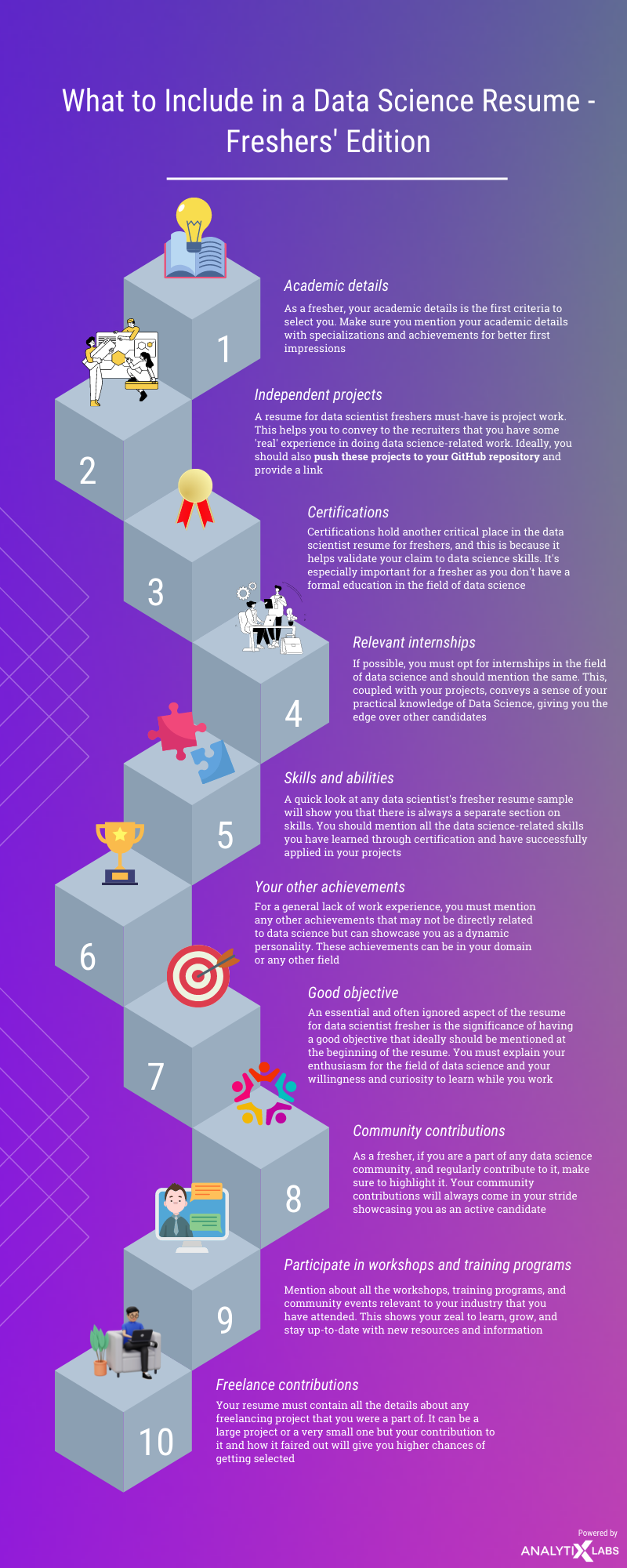
In a data science resume for fresher, two things stand out most prominently:
- Education background
- Skills you have acquired
Make sure you add your contact details prominently so that the recruiter can reach you easily if you are selected. Another bonus point is to add references if you have one.
P.S. References go a long way in cutting the competition easily. So, if you have someone who has referred you, make that count.After all, it’s a win-win for both of you – you get extra brownie points and the one who referred you gets the final credit (read: bonus) once you clear all the rounds and join the company.
Here’s a more detailed guide on creating an effective data scientist resume from Enhancv, the one-stop platform for job-winning resume templates.
Now that you know what to include, it’s time to execute. Learn how to format your resume so that your resume doesn’t get lost in a pile of applications.
Tip #2: Steps to format your data scientist resume
Whether you add new information after every two sentences or repeat the same thing under different headers – how you format your data scientist resume can have a huge impact on your job search.
There is no set rule to format a resume but there are a few things that you can do to ensure your resume is recruiter-friendly. These things include using a formal font, avoiding distractions in your resume, and organizing information in order of importance. Let’s take a look at the steps to format your resume.
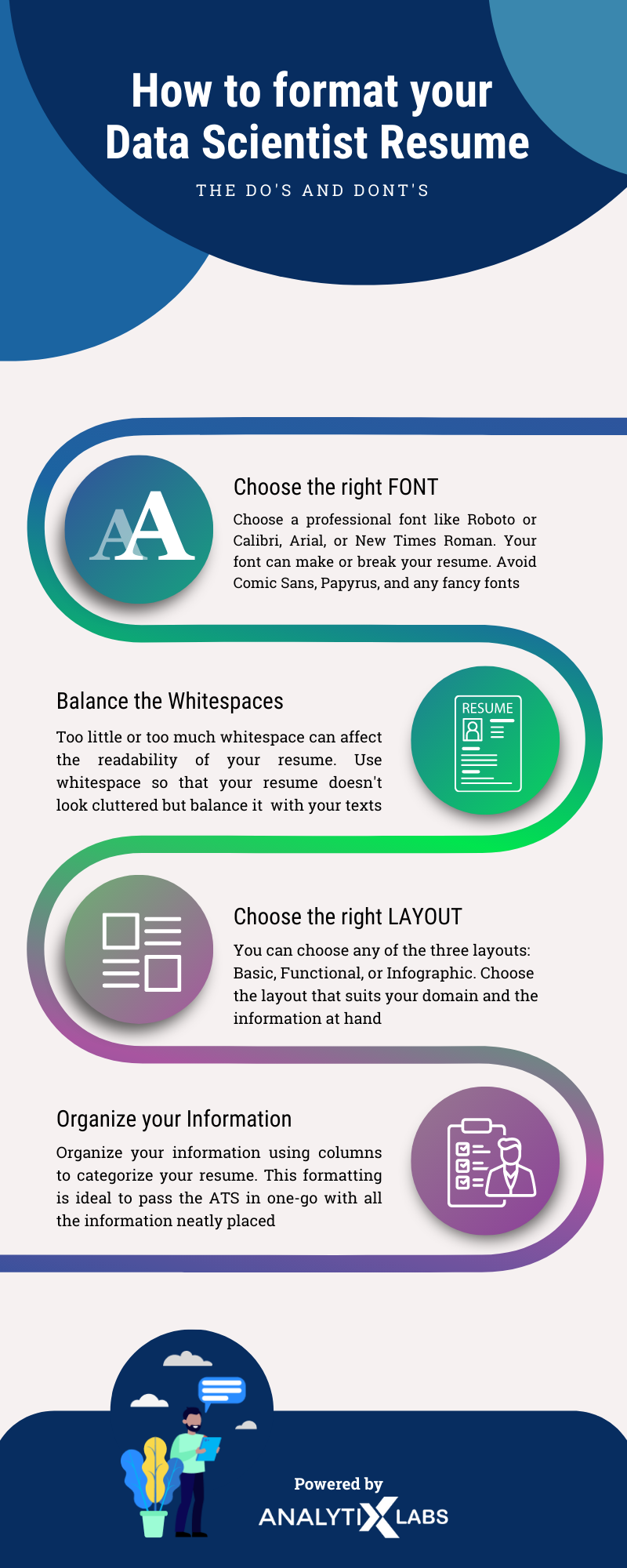
These are the top four tips to format your resume. Now, let’s take a look at how to choose the layout and organize your resume.
-
Choosing the right layout
You can divide your resume into basic, functional, and infographic formats. What do these mean?
| Basic | In Basic, you use headers in bold and present your details in bullet points |
| Functional | Function is a little more advanced where you add different headings, use colors and lines to demarcate your sections, etc. |
| Infographic | Infographic includes the use of icons, graphs, relatively more colors, and different forms of designs to make the resume more visually appealing |
To help you understand better, here’s what each of the resume formattings looks like:
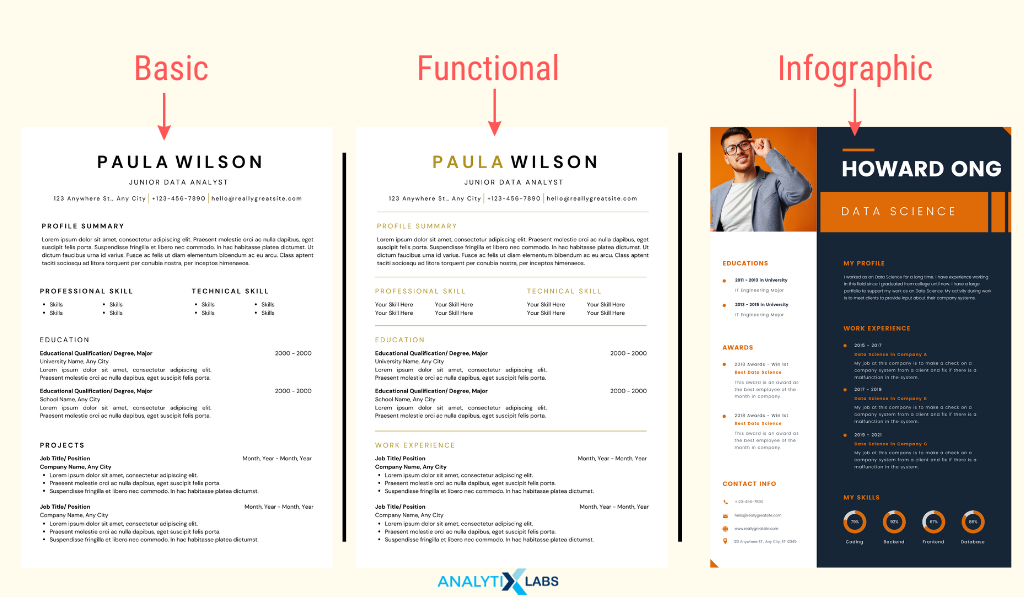
-
Using columns to organize your resume
Another proven way of organizing and formatting your data science resume is to use columns. This is also a secret tip to optimize your resume for applicant tracking software. Columns help in neatly organizing your information and also draw attention to the main information quickly. You can use single columns, double columns, or multiple columns depending on the information you have at hand.
For example, you can have your work experience and project information on one side and skills, certifications, and education on the other. Check out the templates from Enhancv below for reference.
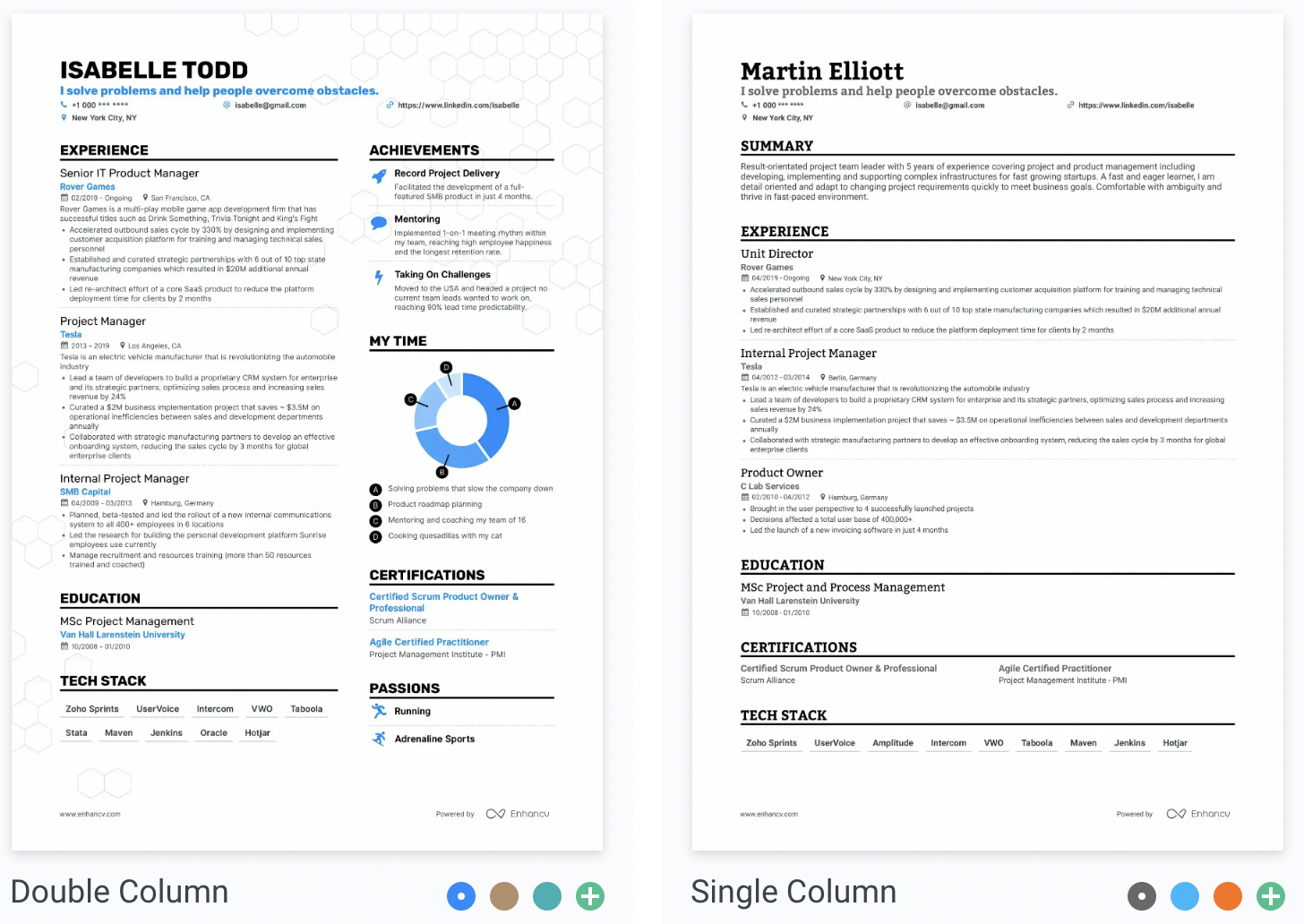
There are two more ways to format/organize your resume –
- Condensed
- Modern
In Condensed format, your information uses less spacing and tries to push as much information through the resume as possible. It is considered ideal for a senior data scientist.
On the other hand, Modern formatting is more compact and rely heavily on infographics. Below are two data scientist resume samples:
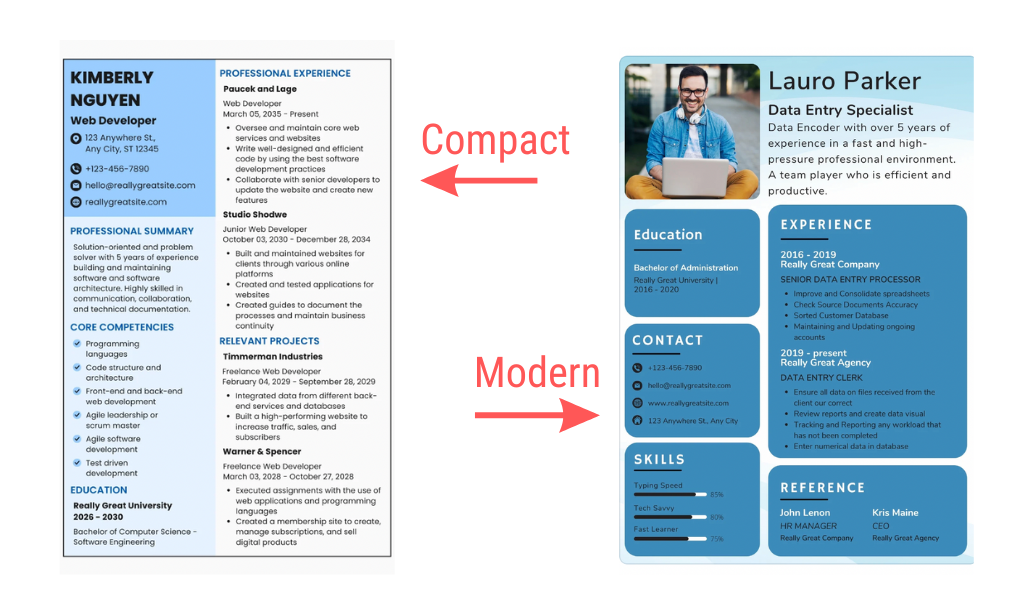
-
Additional formatting methods
There are three more formatting methods that you can follow when creating your data scientist resume:
- Reverse chronology: This format is applicable more when you have relevant field experience. The chronology of your work experience should go from the present company to the first company you worked with i.e. reverse order.
- Functional resume: Here you don’t dive in deep but just mention the job titles you’ve held so far. The focus is on skills in this type of formatting.
- Combination resume: This is a combination of the above two types where one part focuses on the skills and another focuses on your work experience in reverse order.
Tip #3: Ideal data scientist resume structure
An ideal resume structure should have the following chronology:
- Name and contact information
- Career Objective
- Projects
- Kaggle challenges and hackathons
- Training programs and certifications
- Education
- Skills
- Community activities
- Social profiles like GitHub and LinkedIn
Out of these, skills are the most important aspect of a fresher data scientist resume. There are three types of skills for a data scientist – tech skills, hard skills, and soft skills.
| Tech Skills | Skills related to language and software come here. In a data scientist CV, it should have skills like Python, R, SAS, SQL, and even names of libraries like Pandas, NumPy, Matplotlib, etc. |
| Hard Skills | Skills related to the theoretical, analytical, and model development aspects of data science, such as exploratory data analysis, data visualization, data mining, model validation and evaluation, programming, descriptive and inferential statistics, probability, etc. |
| Soft Skills | Skills that are not directly related to data science but are crucial such as communication, collaboration, problem-solving, critical thinking, interpersonal skills, critical thinking, research, time management, etc |
With the above pointers in mind, you are ready to create an ideal data science resume for freshers. However, before we pull down the curtains, let’s go over once again what to keep in your resume and what not.
There are a lot of things you are good at and you’d want to say it all – but the resume is not the place. You will get ample scope to explain your skills when you start giving your interviews. Follow the below checklist to know what to keep in your resume:
What not to include:
- Irrelevant tools that do not pertain to data science
- In-depth details of work experience not related to data science
- Generic school or university projects
Tip #4: Write your contact information correctly
You don’t want your recruiters to miss out on “contact” details once your resume is selected. However, the contact information on your resume is not just about writing your email address or phone number. There are a few to-do’s you want to keep in mind:
- Mention your full name in your resume. Avoid using abbreviated versions of your name.
- Add your personal email ID. No recruiter will want to reach out to your official email ID (applies when you are already working with a company, either full-time or part-time).
- Use the country code and add a hyphen to your phone number. Country codes help recruiters identify your primary location. Ideal format is [country code]-[phone number]. If you are from India, your contact details will look like +91-86*******2. In most cases, avoid adding landline numbers to your resume unless you don’t have a mobile number to add.
- Only add your city name to your resume along with the state. Avoid giving out your entire address in your resume. It’s of no use!
- Add social links for easy validation of your information. As an aspiring data scientist, add your LinkedIn, GitHub, and/or personal blog that you maintain on the relevant subject. Avoid adding the entire URL. Instead hyperlink it, like this: LinkedIn.
That’s it. You are all set to start your job search right away. For any roadblocks, feel free to ping us for career counseling and support, or drop in your comments below for us to reply. Also, to make your resume stand out, you can opt for a PG course and add the skills.
- 50 Python Interview Questions for Data Science
- How to create Data Analyst Resume
- Top 50 Data Science Interview Questions
- How to write an effective Machine Learning Resume
- Top 40 Data Analyst Interview Questions
- Top 45 Machine Learning Interview Questions
- Understanding Data Structures: Types and Applications
- Top reasons to Choose Data Analyst Career Path
Happy job searching!

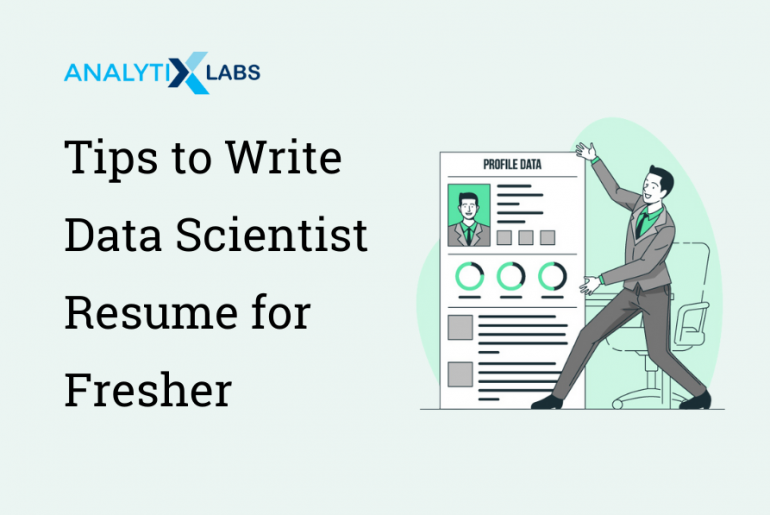



![Tree Traversal in Data Structure Using Python [with Codes] tree traversal in data structure](https://www.analytixlabs.co.in/blog/wp-content/uploads/2025/01/Cover-Image-1-370x245.jpg)


